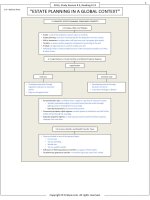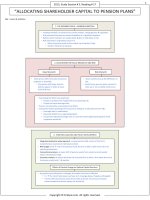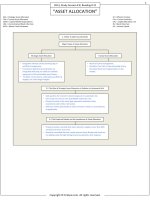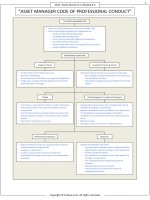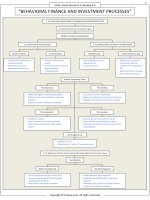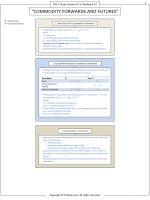FinQuiz smart summary, study session 17, reading 42
Bạn đang xem bản rút gọn của tài liệu. Xem và tải ngay bản đầy đủ của tài liệu tại đây (513.08 KB, 3 trang )
1
2013, Study Session # 17, Reading # 42
“GLOBAL PERFORMANCE EVALUATION”
GPE = Global Performance Evaluation
SD = Standard Deviation
1. PERFORMANCE ATTRIBUTION IN GLOBAL PERFORMANCE EVALUATION
A portfolio is broken down into various segments according to type of asset &
currency to conduct GPE.
Return in local currency: ݎ = ܲ + ݀
where
ܲ = capital gains in %
݀ = yield in %
Return in base currency:
ݎ = ܲ + ݀ + ܥ
where
ܥ = currency component.
Total-return decomposition:
∑ = ݎ ܹ ܲ + ∑ ܹ ݀ + ∑ ܹ ܥ
it is simply the weighted average of the return on all segments.
Performance Attribution
Comparing all major investment decisions with
some passive benchmark.
Security Selection
ܴ = ܫ + ൫ܲ − ܫ ൯ + ݀ + ܥ
Where
ܫ = return in local currency for segment j
൫ܲ − ܫ ൯ = security selection return (assuming the portfolio has
market level risk).
The 1st term measures the performance as the manager invested
passively in a local market index.
Assumption ⇒ price only indexes.
Comparisons with a Global Benchmark
Performance of the total portfolio relative to that of global benchmark.
Portfolio return:
ܹ ∑ = ݎ∗ܫ + ∑൫ܹ − ܹ∗ ൯ܫ + ∑൫ܹ ܥ − ܹ ∗ ܥ ൯ + ∑ ܹ ݀ + ∑ ݓ ൫ܲ − ܫ ൯
where
1st term = international benchmark return in base currency.
2nd term = market allocation contribution.
3rd term = currency allocation contribution.
4th term = yield component.
Last term = security selection contribution.
Manager’s performance can be attributed to:
A market allocation different from that of the index.
A currency allocation different from that of the index.
Security selection.
Risk budgeting ⇒ counterpart of performance attribution in the return dimension.
Copyright © FinQuiz.com. All rights reserved.
2
2013, Study Session # 17, Reading # 42
Currency Management
Passive currency management ⇒ matching the currency weights in the
benchmark.
Currency exposure may be managed by currency overlay manager.
Two ways to analyze active currency exposure:
Country weights different from those in the benchmark.
Active currency bets by the manager.
Derivatives can be used to engage in currency hedging with forward/future
currency contracts.
Multi-period Attribution Analysis
Single Attribute
Multiple Attributes
Difference b/w the portfolio & benchmark return can be
attributed to security selections(S).
For two successive periods:
For each short period, calculate the performance of the
portfolio relative to benchmark & decompose it additively.
Two period contribution processes is similar as single attribute.
Method can generalize over a large number of periods.
ܴଵ − ܴଵ = ܵଵ
ܴଶ − ܴଶ = ܵଶ
where
R = portfolio return
ܴ = benchmark return
These are not simple sum but are linked return.
The correct two period attribute is not equal to either simple
sum or compounded return.
2.PERFORMANCE APPRAISALS IN GLOBAL PERFORMANCE EVALUATION
Risk
Total or Absolute Risk
Relative Risk
Measured by SD over time.
Usually annualized & expressed in % per year.
Active risk ⇒ deviation from passive benchmark.
Usually annualized & expressed in % per year.
Risk-Adjusted Performance
Sharpe Ratio
Information Ratio
Should only be used for the total global portfolio as it
focuses on the total risk of portfolio.
ா௫௦௦௧௨
்
Measures whether the alpha is large relative to
tracking error incurred.
Copyright © FinQuiz.com. All rights reserved.
2013, Study Session # 17, Reading # 42
Risk Allocation & Budgeting
Risk allocation ⇒ Decomposing total risk into various
risk exposures taken.
Risk budgeting ⇒ process of allocating active risk
among managers.
Potential Biases in Risk & Return
Past risk & return figures can be biased estimate of the future because of:
Infrequently traded assets.
Option-like investment strategies.
Survivorship biased risk & return.
3. IMPLEMENTATION OF PERFORMANCE EVALUATION
Traditional approach to evaluate performance ⇒ compares the return on a
managed fund with that of peers.
Performance of an asset manager should be judged relative to customized
benchmarks.
Important issues in constructing customized benchmarks:
Individual country weight.
Countries, industries & style.
Currency hedging.
Copyright © FinQuiz.com. All rights reserved.
3



